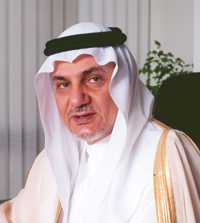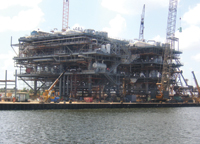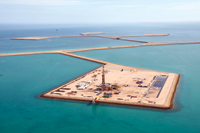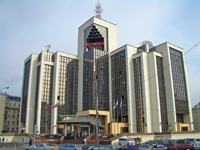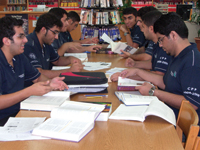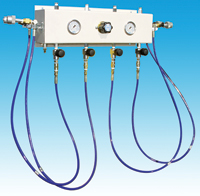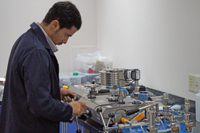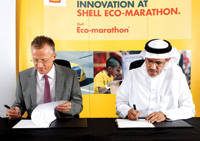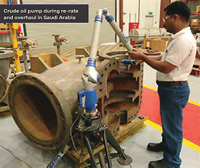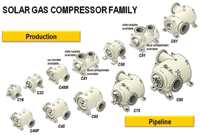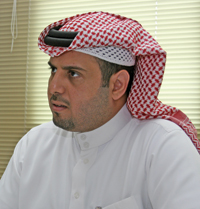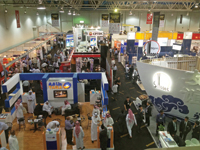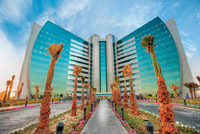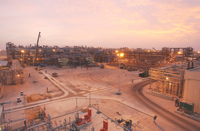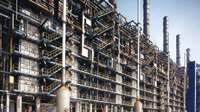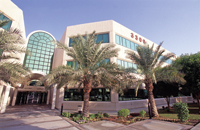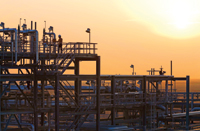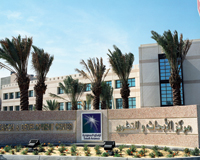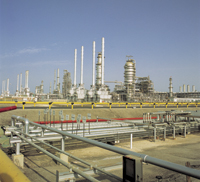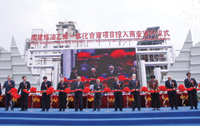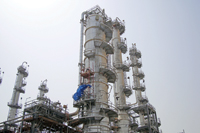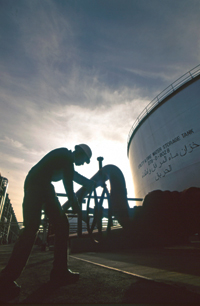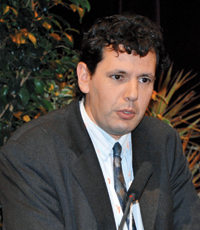
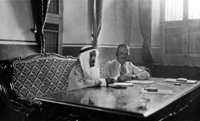 The signing of the historic concession agreement
The signing of the historic concession agreement
THE beginnings of the company, now ranked first among oil companies worldwide in terms of crude oil production and exports and natural gas liquids exports, can be traced to 1933 with the signing of the Concession Agreement with Standard Oil of California (Socal, now Chevron) when King ‘Abd Al-’Aziz directed finance minister ‘Abd Allah Al-Sulayman to “Put your trust in God, and sign.”
In the intervening years, the company has proved itself agile in responding to energy demands and bringing energy to the world.
When signed in 1933, the concession area covered a sprawling 829,000 square kilometres, reaching from the border with Iraq in the north and stretching as far west as Dahna sands and south to the Rub’ Al Khali.
Socal created a subsidiary, Californian Arabian Standard Oil Co (Casoc), to manage the concession.
DISCOVERY
The discovery of the famed Well No 7 (also known as the Prosperity Well) in 1938 would transform Saudi Arabia as a nation and the fortunes of the Saudi people.
That was down to the pioneering spirit of geologist Max Steineke whose persistence resulted in a telegram to San Francisco dated March 4, 1938.
It announced to Socal department heads that Dammam No 7 was producing at a rate of 1,585 barrels per day (bpd) at a depth of almost one and a half kilometres in the Arab Zone of porous limestone.
Later that year, the first barge of Saudi Arabian crude oil was dispatched to Bahrain, and in 1939, the first tanker load of petroleum was exported from Ras Tanura. That was on May 1, 1939, and King ‘Abd Al-’Aziz personally opened the valve that enabled oil to flow into the Socal tanker DG Schofield.
That day marked a milestone and connected the then underdeveloped nation of Saudi Arabia with the industrialised world and ushered in real prospects for prosperity for both the nation and its people.
 |
|
Saudi Oil Minister Ali Al Naimi ... |
THE 1940s: ARAMCO IS BORN
By the 1940s, the potential scale of what lay ahead for the company and Saudi Arabia in terms of energy resources was becoming apparent. In 1944, Casoc changed its name to the Arabian American Oil Company (Aramco). A year later the Ras Tanura Refinery began operations, and in 1948 Standard Oil of New Jersey and Socony-Vacuum Oil (both now ExxonMobil) joined Socal and Texaco as owners of Aramco.
THE 1950s: THE WORLD’S LARGEST FIELDS
The decade began with the completion of the 1,700 kilometre Trans-Arabian Pipe Line (Tapline), linking the Eastern Province oil fields to Lebanon and the Mediterranean.
In 1951, Safaniya field, the world’s largest offshore oil field is discovered. In 1956 Aramco confirmed the scale of Ghawar and Safaniya as the largest onshore oil field and largest offshore oil field, respectively.
Prior to the Second World War, seismic work and structural drilling on the giant En Nala structural fold west of Abqaiq had led geologists to site the first well in an area called ‘Ain Dar.
In little more than three months, on July 22, the company struck oil in substantial quantities at two kilometres in the Arab “D” Zone. As the 1950s progressed, the Ghawar name came to be used for the entire structure.
THE 1960s: FIRST GAS SHIPMENTS
Liquefied petroleum gas (LPG) – propane and butane – was first processed at Ras Tanura before being shipped to customers. In 1966 tankers began docking at “Sea Island,” the new offshore crude oil loading platform off Ras Tanura.
THE 1970s: A DECADE OF RAPID GROWTH
In 1971, Aramco’s production leapt 27 per cent from the previous year, to 4.5 mbpd. Adding, or expanding gas-oil separation plants (GOSPs) increased production capacity by 700,000 bpd.
Over the next few years Saudi Arabia and Aramco assumed the mantle of the world’s “swing producer” of oil, supplanting the US as a company with enough spare capacity to dramatically increase production to meet any shortfalls.
That position is still retained by the kingdom and Saudi Aramco to this day. In 1973, the Saudi Arabian government also acquired a 25 per cent participation interest in Aramco and in 1975 the Master Gas System (MGS) project was launched.
The MGS project was described by the company as “the most ambitious energy project in history” with the goal to industrialise Saudi Arabia.
THE 1980s: TRANSFORMATION
The 1980s was a crucial decade for both the kingdom and the company. The Saudi government assumed full ownership of the company in 1980, and Ali l Al Naimi was appointed as president of the company in 1984.
In 1981, the East-West NGL Pipeline linked the Eastern Province with Yanbu’, on the Red Sea, while in 1982 the Exploration and Petroleum Engineering Centre (Expec) opened in Dhahran.
In November 1988, Saudi Arabia’s Council of Ministers met and approved the charter of a new national oil firm – the Saudi Arabian Oil Company, or Saudi Aramco – to assume the responsibilities previously carried out by Aramco on behalf of the government.
In 1989, high-quality oil and gas was discovered south of Riyadh, the first find outside the company’s original operating area. Saudi Aramco and Texaco launched the Star Enterprise refining and marketing joint venture in the US.
THE 1990s: CRISIS AND GROWTH
The 1990s opened with the Gulf Crisis. In addition to the security concerns, Saudi Aramco faced challenges unprecedented in the company’s history, not least protecting the fragile ecosystem of the Arabian Gulf.
In 1993, the progression of the company continued with Saudi Aramco assuming control of the kingdom’s domestic refining, marketing, distribution and joint venture refining interests.
Maximum sustainable crude oil production capacity returned to 10 million bpd in 1994, and the next year the company completed a programme to build 15 very large crude carriers (VLCCs).
Saudi Aramco’s president and CEO was also named the kingdom’s Minister of Petroleum and Mineral Resources. The Shaybah oil field in the remote Rub Al Khali desert, one of the largest projects of its kind anywhere in the world, came onstream.
THE 2000s: EXPANSION IN A NEW CENTURY
After revisiting the kingdom’s oil and gas strategies, the Saudis made headline news when it was announced in May 2005 that the government had earmarked tens of billions of dollars over five years for one of the largest oil industry capital spending programmes anywhere in the world.
Taken as a whole, the new facilities were designed to boost Saudi Aramco’s maximum sustainable production capacity of crude oil by 2 mbpd to about 12 mbpd.
The natural gas would be used to spur Saudi Arabia’s industrial growth, especially in the area of petrochemicals. In 2001, the Hawiyah Gas Plant, capable of processing up to 1.6 billion standard cubic feet per day (scfd) of nonassociated gas, came onstream. Haradh Gas Plant followed in 2003, with a capability to process up to 1.6 billion scfd of nonassociated gas, while in 2004 Qatif Producing Plant began operations with a crude oil production capacity of 800,000 bpd.
Haradh III Crude Oil Increment came onstream with a capacity of 300,000 bpd. In 2008 Saudi Aramco celebrated its 75th Anniversary, and as a gift to the people of Saudi Arabia, launched a project to build the King Abdulaziz Centre for World Culture in Dhahran.
THE FUTURE: AIMING EVEN HIGHER
Saudi Aramco has signalled its ambitious strategic intent for 2020 that will define its direction for the next two decades.
By 2020, Saudi Aramco intends to be the world’s leading integrated energy and chemicals company, focused on maximising income, facilitating the sustainable and diversified expansion of the kingdom’s economy, and enabling a globally competitive and vibrant Saudi energy sector. Saudi Aramco continues to lead the industry in upstream operations and has made significant progress in two major offshore developments: Manifa, the world’s fifth largest oil field, and Karan, the kingdom’s first nonassociated offshore gas field.
Progress has also been made on the Wasit Gas Plant, which will be one of the largest integrated plants Saudi Aramco has ever built. In late 2012, contracts for the construction of the Jazan Refinery and Terminal Project (JRTP) were signed.



































































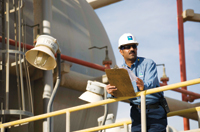
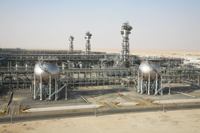
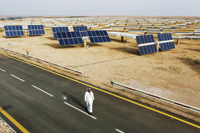


.jpg)
